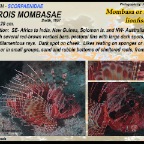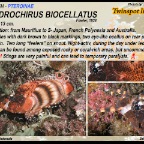Lionfish - Pteroinae
LIONFISH - PTEROINAE
These very popular and elegant fish are the only one of the scorpionfish family that really swim. Most of the time they are seen hovering over the reef or areas with sand, rubble or seagrass. However, Lionfish are very rarely seen swimming in open water. As with all others of the family, they are a bit lazy and don't swim long distances. They mostly live alone but can be observed hunting in groups of more than 20 individuals. Their long pectoral fins are not only used for swimming but also to close in on small fish, which they suck in. When divers or snorkelers come close, they will turn their dorsal fins with poisonous spines towards the intruder. During the mating season, the males become very aggressive and start to fight with other male or females. Mating and the releasing of eggs happens just after sunset. Like many other fish they swim a bit in open water and on the highest point, release the eggs which will be carried away by the current. Warning! Wounds caused by their poisonous stingers cause severe pain, swellings, temporary paralysis but are not life threatening. Length: 20 cm.Distribution: E- Africa to Samoa, S- Japan and Lord Howe.Pectoral fins connected with membrane, small white dots in black area of the fin.A shy species, males are very territorial. Nocturnal feeders.Mosly under ledges in deep lagoons or seaward reefs, down to -35 m.Warning! Stings are very painfull and can lead to temporary paralysis. Length: 13 cm.Distribution: from Mauritius to S- Japan, French Polynesia and Australia.Red scales with dark brown to black markings, two eye-like ocellus on rear part of dorsal fin. Two long “feelers” on snout. Night-activ, during the day under ledges or in holes. Can be found among exposed rocky or coral-rich areas, but uncommon. Warning! Stings are very painful and can lead to temporary paralysis. Length: 20 cm.Distribution: E- Africa to French Polynesia, S- Japan and Great Barrier Reef.Supraorbital tentacles variable in length, may disappear in large adults. Membrane always spotted. From reef flats to -50 m. Feeds primarily on crustaceans. Usually under ledges or in holes by day.Warning! Stings are very painfull and can lead to temporary paralysis. Length: 17 cm.Distribution: from the Red Sea to Samoa, S- Japan and Tonga.Pectoral fins completely connected with membrane, max 10 brown bands on pec. fin. Prefers shallow sheltered reefs, often on isolated weed-covered rocks in sandy areas or seagras fields. Active at night.Warning! Stings are very painfull and can lead to temporary paralysis. Length: 36 cm.Distribution: Indian Ocean only, Red Sea to Sumatra, Andaman Sea and S- Africa.Maybe a sub-species of P. volitans. Very common in lagoons and seaward reefs, down to -50 m. Often found under ledges by day, activ during dusk and night time. A slow swimmer but is able to swim very fast for a short time. Points his spines forward if it has to protect itself. Warning! Stings are very painfull and can lead totemporary paralysis. Length: 38 cm.Distribution: Malaysia and Bali to S-E. Polynesia, S- Japan and Lord Howe.Nearly indistinguishable from P. miles, spots on soft vertical fins somewhat larger. Can be found in lagoons and seaward reefs, down to -50 m. Feeds on fishes and crustaceans. Unafraid, often stand their ground when approached.Warning! Stings are very painfull and can lead to temporary paralysis.





















